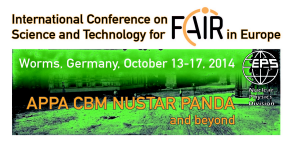Speaker
Ms
Irina Ivanova
(St. Petersburg State University)
Description
Nowadays, laser technologies are rapidly developed. For instance, there is PHELIX facility (The Petawatt High-Energy Laser for Heavy Ion EXperiments) [1] at GSI (Darmstadt). This facility allows us to obtain extremely intense laser fields. Highly charged ions are the ones of the most interesting objects that can be experimentally studied with such strong fields. FAIR will provide a unique opportunity to carry out ionization experiments with highly charged hydrogenlike ions (up to uranium) exposed to strong laser fields from PHELIX facility for testing QED effects in extremely intense fields. The theoretical description of the process under consideration is needed for such experiments at FAIR.
In present work the time-dependent Dirac equation for a highly charged hydrogenlike ion in presence of a strong laser field was solved numerically. The interaction with the intense electromagnetic pulse was considered within the dipole approximation in the length gauge. At the first stage the stationary problem in the Coulomb potential of the nucleus was solved with the dual kinetic-balance (DKB) approach [2], in which the basis functions are constructed from B-splines. The DKB approach provides a solution of the stationary radial Dirac equation. A significant advantage of this approach is the absence of spurious states. At the second stage the time-dependent problem for a hydrogenlike ion in presence of a strong electromagnetic field was solved. The time-dependent Dirac wave function was expanded in terms of the stationary Dirac equation solutions. The expansion coefficients were found employing the Crank-Nicolson propagation scheme [3].
Relativistic calculations of the excitation and ionization probabilities in highly charged ions exposed to strong laser fields were performed. Also convergence properties of the excitation and ionization probability values with respect to different basis set parameters used in the calculations were studied.
References
[1] PHELIX (The Petawatt High-Energy Laser for Heavy Ion EXperiments)
[https://www.gsi.de/en/start/research/forschungsgebiete_und_experimente/
appa_pni_gesundheit/plasma_physicsphelix/phelix.htm].
[2] V. M. Shabaev, I. I. Tupitsyn, V. A. Yerokhin, G. Plunien, and G. Soff, Phys. Rev. Lett. 93, 130405 (2004).
[3] J. Crank and P. Nicolson, Proc. Cambridge Philos. Soc. 43, 50 (1947).
Primary author
Ms
Irina Ivanova
(St. Petersburg State University)
Co-authors
Mr
Andrey Bondarev
(St. Petersburg State University)
Mr
Ilia Maltsev
(St. Petersburg State University)
Vladimir Shabaev
(GSI, Darmstadt)

